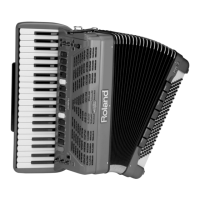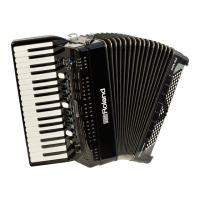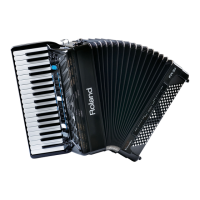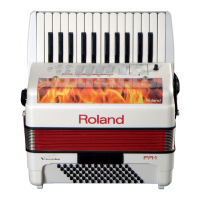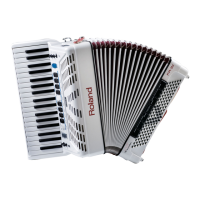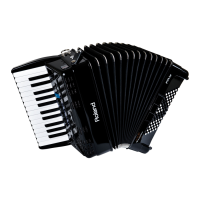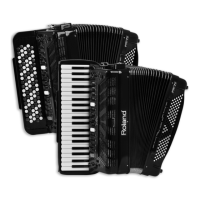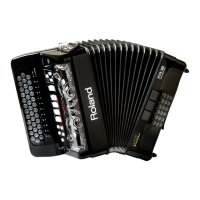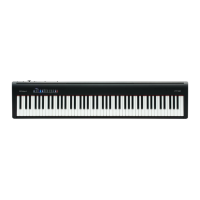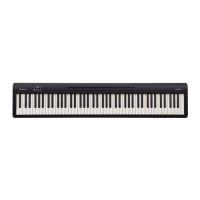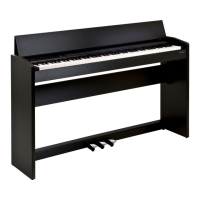Selecting Parameters
79
4.6 Name
This parameter allows you to name the currently
selected Free Bass register for easy reference while
performing with the FR-8x.
The FR-8x suggests the name of selected register.
1. Use the [DATA/ENTER] knob to enter the desired name.
See “How to type a name in FR-8x” (p. 31).
2. Press [EXIT/JUMP] button to exit from the selection.
5. Orchestra 1 Edit parameters
The parameters of the “Orchestra 1 Edit” group apply to the right
hand orchestra section. See “Playing Orchestral Sounds” (p. 35)
for details about the Orchestra section. They can be saved to the
selected Set.
See “Selecting Parameters” (p. 68) for how to select and adjust
the parameters.
Press [UP] and [DOWN] simultaneously to select the value that is
indicated as “Default setting”.
NOTE
These parameters can only be selected if the Orchestra 1 section
is activated ([ORCH 1] button indicator lights).
Introduction to Orchestra 1 Parameters
All changes you make here apply to the last Orchestra 1 register
you selected. So be sure to select RIGHT HAND [ORCH1] button
and press the register whose settings you wish to change before
selecting and editing any of the Orchestra 1 Edit parameters. You
can, however, decide to save your settings to a dierent register if
you realize that you’ve been editing the wrong one.
IMPORTANT NOTE
The FR-8x internal memory remembers your settings while the
FR-8x is switched on. While editing, there is no absolute need
to save your settings. Be aware, however, that all changes are
lost when the FR-8x is switched o.
See “How to Save a Set” (p. 42) to save your changes. Also
be sure to read “Important remark about saving your settings”
(p. 70).
5.1 Tone Selection
Thee parameters group allows you to assign the
desiderate orchestra sound, to transpose the
Orchestra section, to adjust the volume and the
panpot.
Parameter Value Explanation
TONE
For details regarding
this settings refer to
the“Tone & Drum Kit List “
supplementary manual.
Download it from the
Web:
http:/ www.roland.com/
manuals/
This parameter allows you to
assign the desired orchestral
sound to the selected register.
Parameter Value Explanation
OCTAVE –3~0~+3
This parameter allows you
to transpose the Orchestra 1
section (i.e. the currently selected
orchestral 1 sound) up or down.
This can be interesting when you
are using the Orchestra 1 part in
layer mode ( p. 33) and want
it to sound above or below the
selected treble accordion register.
VOLUME O, –40~Std~40
This parameter allows you to set
the Orchestra 1 section’s volume.
This is a relative parameter, which
means that its value is added to
or subtracted from the standard
value (“Std”).
PANPOT 63 Bass~0~63 Treble
Depending on the selected
sound, this parameter allows you
to change the Orchestra 1 part’s
placement in the stereo sound
eld (i.e. between the left and
right speakers) to create a livelier
sound image.
The “Treb” values mean that the
sound will appear on the same
side as the Right Hand (treble)
accordion sound. This setting
applies to both the FR-8x internal
speakers and the L/MONO socket.
The “Bass” values mean that the
sound will appear on the same
side as the bass accordion sound.
This setting applies to both the
FR-8x internal speakers and the R/
MONO socket.
Choose “0” if the Orchestra 1
sound should be at the center of
the stereo image.
5.2 Eect Send
The FR-8x contains 1 multi-eects processors
(“MFX”), one reverb processor, one chorus
processor and one delay processor that can be
used to process the Orchestra 1 section.
Parameter Value Explanation
REVERB
0~127
Use these parameters to set the Reverb,
Chorus or Delay send levels (how
much eect should be applied to the
Orchestra 1 section).
CHORUS
DELAY
MFX O, On
Select “O” if you don’t need the MFX
processor.
MFX Type See the table below.
The FR-8x provides 84 dierent
multi-eect types, some of which are
combinations of two eects for added
exibility. This parameter allows you to
select the desired type.
The MFX available types are:
N. Mfx Type N. Mfx Type N. Mfx Type
1 Thru 29
OD Delay
57 VK Rotary
2 Stereo EQ 30
DST Cho
58 3D Chorus
3 Overdrive 31
DST Flgr
59 3D Flanger
4 Distortion 32
DST Delay
60 3D Step Flgr
5 Phaser 33
EH Chorus
61 Band Cho
6 Spectrum 34
EH Flanger
62 Band Flgr
7 Enhancer 35
EH Delay
63 B. Step Flgr
8 Auto Wah 36.
ChoDLY
64 VS Overdr.
9 Rotary 37
Flgr DLY
65 VS Distort.
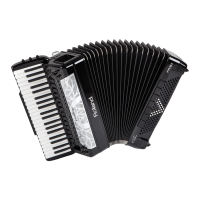
